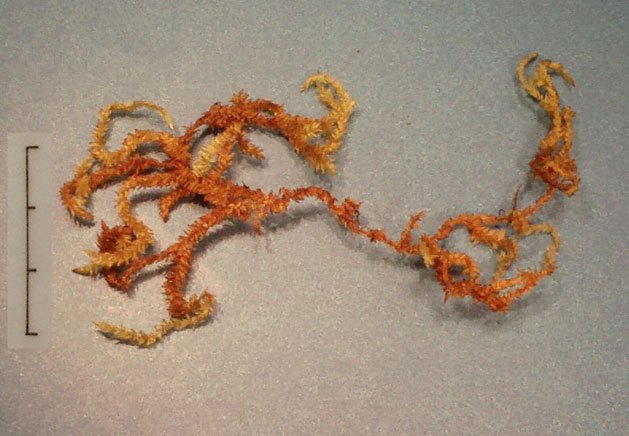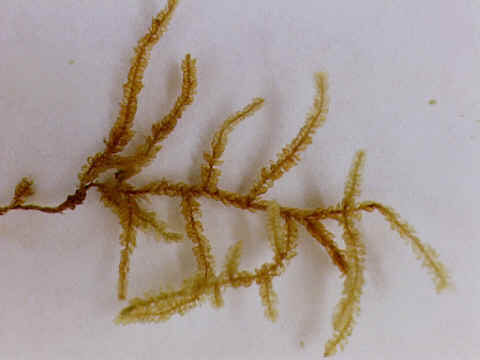![]()
|
|
|
|
|

|
Introduction |
|
1. Description of the genus 2. Key to the
Neotropical species of Pilotrichella 3. Taxonomic
treatment |
|
Pilotrichella is a tropical pleurocarpous moss genus containing around 50 names. This preliminary work treats the Neotropical members of Pilotrichella (P. cuspidans, P. flexilis and P. quitensis). Pilotrichella pentasticha is confirmed as being Orthostichella, as proposed by Buck (1994). 1. PILOTRICHELLA (Müll. Hal.) Besch., Mém. Soc. Sci. Nat. Cherbourg 16: 222. 1872. Plants light or dark green to golden brown, mostly large and robust, forming loose mats or pendent. Primary stems short to long creeping, rhizoids clustered beneath, rusty-red, leaves erect to appressed, broadly ovate-oval. Secondary stems pendent or spreading, to 30 cm or more long, in cross-section 3-5 outer cell rows small, thick-walled and reddish-orange, inner cells large, ± thick-walled, pale yellow or hyaline, central strand absent, present only in P. quitensis. Leaves imbricate, erect-spreading, stem and branch leaves similar to somewhat differentiated, those of the stem often somewhat small, broadly ovate to oblong-ovate, deeply concave, acute-rounded, cuspidate or subpiliferous with tips erect to reflexed, base auriculate, clasping; margins incurved, usually strongly so distally, entire or serrulate distally or from above the base, ecostate (costate in P. quitensis), lamina cells strongly to weakly porose or occasionally walls entire/straight, median cells linear, firm-walled; alar region strongly differentiated, excavate, cells subquadrate to short rectangular, thick-walled, sometimes weakly porose, usually dark red or reddish-orange, basal cells golden-yellow. Dioicous. Perichaetial leaves sheathing. Setae elongate, to distally roughened, rusty-red. Capsules exserted, erect, urn ovoid to ovoid-short cylindrical (broadly ovoid when deoperculate). Opercula obliquely long rostrate. Peristome teeth double (not observed). Calyptrae cucullate, hairy below, hairs ± erect. Spores not observed. Buck (1994) has proposed that Pilotrichella be placed with Squamidium and Weymouthia in the Lembophyllaceae. Furthermore Buck subdivides Pilotrichella with P. flexilis (Hedw.) Ångstr. maintained as the type species, and includes a related Andean species P. quitensis (Mitt.) A. Jaeger; finally Pilotrichella pentasticha (Brid.) Wijk. & Margad. is placed in the genus Pseudopilotrichum, however an earlier generic name, Orthostichella, appears to have priority (Buck, 1994b). |
1.
Leaves appearing lanceolate-ovate, leaf tip piliferous; Cuba and Hispanola .... P. cuspidans 1. Leaves
ovate-oval to ovate-oblong, leaf tip shortly cuspidate or apiculate, to
rounded ...... 2. 2. Leaf apices shortly cuspidate or
apiculate, erect ...................................... P. mauiensis 2. Leaf apices obtuse-rounded to
broadly acute and reflexed ....................................... 3. 3. Stem
leaves ovate-oval, apices obtuse-rounded; short double costa present on all
or most leaves; stem cross-section with central strand present .............................. P. quitensis 3. Stem
leaves ovate-oblong, apices acute-rounded, tip reflexed; costa absent; stem
cross-section lacking a central strand ........................................................................................................ 4. 4. Plants typically golden yellow or
brown; laminal cells porose ........................ P. flexilis 4. Plants dark green; laminal
cells entire, not prose; Mexico, southeast Brazil ........... P.
sp.
3. Taxonomic treatment Pilotrichella
cuspidans Renauld
& Cardot, Bull. Soc. Roy. Bot. Belgique
29(1): 180 1890. Type: Haiti, Port au Prince, ad truncos
arborum, Bertrand s.n. (isotypes: H-BR, S). Plants medium sized to
rather large, forming mats or becoming pendent, glossy light green to
golden-yellow. Primary stems
creeping; Secondary stems
spreading to pendent, to 8 cm long, irregularly pinnately branched, branch
tips attenuate; in cross-section outer 3-4 rows of cells small and
thick-walled, inner cells larger, thin to firm walled, central strand absent.
Leaves spirally
foliate, loosely imbricate, strongly so at branch tips, erect-spreading dry
or wet, oblong-ovate and cuspidate, 2.0-2.8 mm long, to 1.2 mm wide, concave,
piliferous tip 0.3-0.7 mm long, base rounded to weakly auriculate; margins
strongly incurved distally, entire to faintly serrulate, particularly so at
juncture of margin and piliferous apex; costa absent; laminal cells porose,
median cells linear, 60-70 µm long, 3-4 µm wide; insertion cells often
golden; alar cells numerous, irregularly quadrate-round or -oblong, 10-20 µm
long, 10-12 µm wide, golden-brown, very thick-walled, porose or not. Dioicous. Sporophytes unknown. Ecology
and distribution. Premontane
to montane forests including tree ferns, palms (Prestoea), and Magnolia
at high elevations; shaded to partly shaded sites, on logs and tree
trunks. At elevations from 1000-1800
m. Greater Antilles, Cuba, Dominican
Republic, Haiti. Apparently only
common in the Dominican Republic. Specimens
examined. CUBA. Prov. de Oriente, El Como, Jan 1920, Clement
s.n. (S). DOMINICAN REPUBLIC. Barahona: Zanoni et al. 20348-G
(MO); La Vega: Zanoni et al. 20200-S (MO); Peravia: Zanoni et al.
19856-I (MO). HAITI. See type.
Pilotrichella cuspidans bares
some resemblance to the recently described Renauldia paradoxica
B. H. Allen (Allen, 1987), but that species is larger with leaves to 4.2 mm
long and a leaf base strongly auriculate. It also differs by the presence of
filamentous pseudoparaphyllia. Pilotrichella
flexilis (Hedw.)
Ångstr., Kongl. Svenska Vetensk. Acad. Handl. 33 (11): 34. 1876. Leskea flexilis Sw. ex
Hedw., Sp. Musc. Frond. 234.
58. 1801. Type:
Jamaica et insulae australes, Swartz? (G?). Plants light green to
golden brown, mostly large and robust, forming loose mats or pendulous
strands. Primary stems
short to long creeping; leaves erect to appressed, broadly ovate-oval, ca.
1.2 mm long, to 1.0 mm wide, apex obtuse-rounded; rhizoids clustered beneath,
rusty-red. Secondary stems
often pendent, to 30 cm or more long, irregularly branched; in cross-section
4-5 outer cell rows small, thick-walled and reddish-orange, inner cells
large, somewhat thick-walled, pale yellow, central strand absent;
pseudoparaphyllia foliose; axillary hairs uniseriate, 1-2 basal cells short,
brown, upper 1-3 cells long, mostly hyaline.
Leaves imbricate, erect-spreading to loosely spreading,
stem and branch leaves similar, those of the stem often somewhat small, 2-3
mm long, to 1.6 mm wide, deeply concave, apex acute and often cuspidate with
tips mostly reflexed, based strongly auriculate, clasping base; margins
incurved, usually strongly so distally, entire; ecostate; lamina cells
strongly porose, median cells 50-80 µm long, 4-6 µm wide; basal cells
golden-yellow; alar region strongly differentiated, cells subquadrate to
short rectangular, 10-18 µm long, 8-12 µm wide, thick-walled, weakly porose,
usually dark red or reddish-orange. Dioicous. Perichaetia lateral; leaves sheathing,
outer leaves as short as 1.5 mm long, inner leaves oblong-lanceolate, 3.5-4.0
mm long, short acuminate; ecostate, laminal cells long linear and
porose. Setae elongate,
12-15 mm long, distally roughened, rusty-red. Capsules exserted, erect, urn ovoid to
ovoid-short cylindrical (broadly ovoid when deoperculate), 1.8-2.0 mm long; opercula
long rostrate, 1.6-1.8 mm long; peristome teeth double (not
observed). Calyptrae
cucullate, 2.8-4.0 mm long, hairy below, hairs (paraphyses) ± erect. Spores not observed. Ecology
and distribution. Premontane
to high montane forests, not common in moderately disturbed secondary
forests; exposed to, more commonly, partly shaded sites, rare in deep shade;
epiphytic, on trunks or more commonly on branches, equally frequent on logs,
and occasionally on humus or rocks.
Frequent at elevations from 1080-3550 m. Mexico, Central America, West Indies (1080-2600 m), tropical
Andes, southeast Brazil, and Africa. Specimens
examined. BELIZE: Toledo: Allen 18524 (MO). GUATEMALA. Quetzaltenango: Sharp 2207
(MO). EL SALVADOR. Trail to Los Planes de Miramundo, Watson
ES-0125 (MO). COSTA RICA. Puntarenas: Lyon 489 (MO); San
Jose: King C-74-074-A (MO). CUBA. Oriente: Hioram 12298 (MO), Oriente: Granma, Pócs
& Duany 9083-A (MO). JAMAICA. St. Andrew: Crosby 13794 (MO); St.
Thomas: Crosby 1299 (MO). DOMINICAN REPUBLIC.
Peravia: Zanoi et al. 19208-C (MO); La Vega: Norris 5724
(MO). PUERTO RICO. Cerro dela Punta, Steere 6178 (MO);
El Yunqui, Steere 4018 (MO). VENEZUELA. Barinas: Dorr et al. 4872 (MO);
Bolívar: Steyermark & Wurdack 844 (MO); Carabobo: Steyermark
& Steyermark 95564 (MO); Distrito Federal: Steyermark et al.
127943 (MO); Falcon: Griffin & Wingfield PV-1646 (MO); Lara: Steyermark
et al. 103588 (MO); Mérida: Griffin et al. 017476 (MO);
Portuguesa: Steyermark et al. 126620 (MO); Trujillo: Griffin &
López F. PV-1372 (MO). COLOMBIA. Antioquia: Escobar A. et al. 1025
(HUA, MO, NY); Boyacá: Churchill et al. 19011 (COL, MO, NY);
Santander: Lewis 88-1307-d-4 (MO); Valle: Churchill
et al. 15342 (CUVC, MO, NY). ECUADOR. Loja: Holm-Nielsen et al. 3679
(MO). BOLIVIA. Cochabamba, Carrasco: Nee et al. 36500
(MO); La Paz, Inquisivi: Lewis 89-962-d-3 (MO). Pilotrichella
quitensis (Mitt.) A.
Jaeger, Ber. Thätigk. St. Gallischen Naturwiss Ges. 1875-76: 257. 1877.
Meteorium quitense Mitt., J. Linn. Soc., Bot. 12: 439.
1869. Type: Ecuador,
"Andes Quitenses", Jameson (NY?); in monte Pichida (11000 ped.),
Spruce 1042 (NY, H-BR? ). Lembophyllum bolivianum
Herzog, Biblioth. Bot. 87: 123. 1916.
Type: Bolivia. “Zwischen Gras in der Felsschlucht von Toncoli, can
3500 m, No. 4382 [Herzog, JE n.v.]; an der Waldrenze des Rio Saujana ca. 3500
m, No. 3250/a [Herzog, JE n.v.]. Plants rather large, forming
loose spreading mats or becoming pendulous.
Primary stems creeping.
Secondary stems spreading or pendent, to 12 cm long, reddish-brown,
irregularly pinnately branched, branches mostly 1-2 cm long, usually bluntly,
occasionally narrowly, attenuate, flagellate tips infrequent; in
cross-section outer 3-4 rows of cells small, very thick-walled,
reddish-orange, inner cells larger, firm- to somewhat thick-walled,
progressively thin-walled toward center, central strand present, weak to
distinct. Stem leaves spirally
foliate, imbricate, little differentiated when dry or wet, ovate-oval,
1.5-2.0 mm long, 1.1-1.5 mm wide, concave, apex obtuse-rounded, base weakly
auriculate; margins subentire to weakly serrulate, often distinctly serrulate
distally; costae present on most leaves, short and double or forked; median
cells linear, 35-60 µm long, 3-4 µm wide, smooth, walls firm to rather thick-walled,
entire to weakly porose; apical cells shorter than median, 8-20 µm long; alar
cells excavate, partially bistratose, mostly 4-5 cells high, 6-8 cells wide,
thick-walled, golden yellow or brown. Branch leaves, margins incurved,
strongly serrulate. Dioicous. Sporophytes unknown. Ecology
and distribution. Upper open
forested montane; on shrub or base and trunk of trees, occasionally over
humus and leaf litter. At elevations
from ca. 3000-3780 m. Tropical Andes,
from Ecuador to Bolivia. Specimens
examined. ECUADOR. See type.
PERU. Prov. La Convencion, 3080
m, Oct 1920, Bües 1471 (NY); 3235 m, Oct 1920, Bües 1468a (NY);
3450 m, Aug 1922, Herrera 2b (NY). BOLIVIA. La Paz, 3750 m, Lewis
38580-d-1 (MO); Larecaja, 3220 m, Lewis 83-89 (MO),
3780 m, Lewis 79-1341 (MO). Comments. Nicely illustrated by
Herzog (1916: page 126, fig. 53) as Lembophyllum bolivianum.
Webpage designed by M.J. Price, May
8th, 2001.
![]()
![]()



